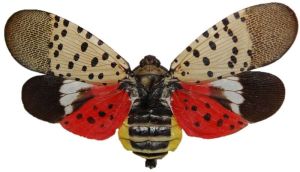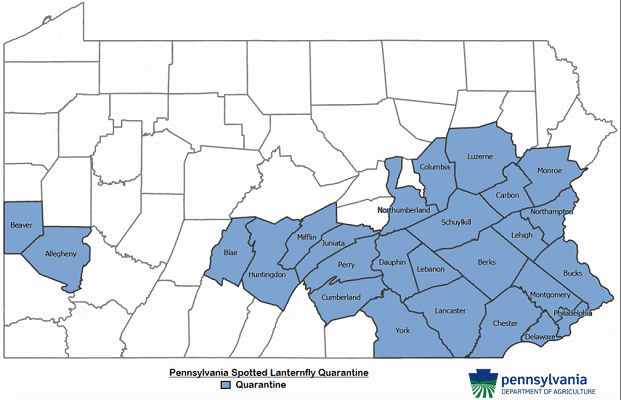One of the most significant threats to hardwood and agriculture here in Pennsylvania is a relatively new one: the Spotted Lanternfly.
What is the Spotted Lanternfly?
The Spotted Lanternfly is an invasive planthopper native to Asia. It was first discovered in Pennsylvania in Berks County in the fall of 2014 and has spread to other counties in southeastern Pennsylvania as well as some neighboring states. This insect has the potential to greatly impact agricultural crops such as grapes, hops, and especially fruits.
What to look for.
In the winter, look for their brown, muddy like egg masses around your property. They can be found, not only on trees, but under decks and porches, on gas grills, campers and boats.
This spring, beginning in late April to mid-May, search for the nymphs on smaller plants and vines, and any new growth on trees and shrubs. Fruit trees and grapes may be more susceptible to damage and mortality when larger populations of Lanternflies are found.
As they approach maturity in the mid to late summer, adults will swarm. They will attack trees, fruits and vegetables. They leave a sappy substance called “honey dew” which quickly molds. This process leaves a mess on buildings and renders fruit and vegetables valueless. The Spotted Lanternfly begins laying eggs in masses of 30 to 50 eggs, covered in a brown, mud-like substance. Egg laying can occur until there have been a couple of killing frosts.
What to do.
Spotted Lanternfly can be controlled with a combination of physical removal, stop to your hearts content, of life stages and host trees (mostly tree of heaven). Placing sticky bands around tree trunk can be helpful.
You can also take steps to limit the chance you may spread Spotted Lanternfly by using the Spotted Lanternfly Quarantine Checklist to make sure items on and around the home are pest free before moving them.
If you are outside the quarantine zone and discover the Spotted Lanternfly on your property. Kill them if possible and report your findings to the Department of Agriculture for your location.
Are you in the quarantine zone?
There is currently a quarantine in place to stop the movement of Spotted Lanternfly to new areas within or out of the current quarantine zone (which has now spread to 26 counties) and to slow its spread within the quarantine. The quarantine affects a variety of vehicles as well as plant, wood, and stone products.
It is important to join the effort to control and prevent the spread of Spotted Lanternfly. Here at A.M. Logging, we have completed the Pennsylvania State training and testing for the Spotted Lanternfly as well as established our best management practices. We completed our Department or Agriculture certification as well as registration. To learn more about the Spotted Lanternfly and how if might affect your area, contact https://extension.psu.edu/spotted-lanternfly.
To learn more about our timber harvesting services, please call us at 814-349-8089 or request a quote online.
